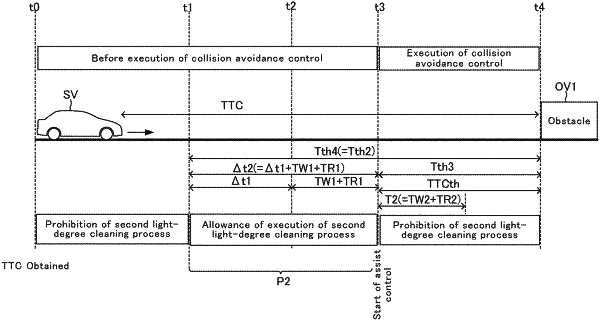| CPC B60S 1/485 (2013.01) [B60S 1/56 (2013.01); B60W 30/08 (2013.01)] | 7 Claims |

|
1. A vehicle control apparatus comprising:
a first on-board sensor configured to obtain object information of an object that is present around a vehicle, using an electromagnetic wave which passes through a first detecting surface part exposed to outside of said vehicle;
a second on-board sensor configured to repeatedly obtain image data of said object that is present around said vehicle, using light, as an electromagnetic wave, which passes through a second detecting surface part exposed to outside of said vehicle;
a first cleaning unit configured to be capable of performing a first cleaning operation to clean said first detecting surface part using cleaning fluid;
a second cleaning unit configured to be capable of performing a second cleaning operation to clean said second detecting surface part using cleaning fluid;
a storing device configured to store information including said image data;
a driving assist device including at least one of a control actuator configured to change a state of said vehicle and a warning device configured to generate a warning to an occupant of said vehicle; and
a control unit configured to:
control said first cleaning unit;
obtain, based on said object information, a collision probability indicating value correlated with a probability that said vehicle collides with said object;
cause said driving assist device to start performing a driving assist operation to avoid a collision between said vehicle and an obstacle that is said object, from an assist start time point at which collision probability indicating value of said obstacle satisfies a predetermined driving assist condition;
obtain a first dirty degree indicating value representing a degree of dirtiness of said first detecting surface part;
start a first normal cleaning process to cause said first cleaning unit to perform said first cleaning operation for a first normal duration, when a first normal cleaning condition becomes satisfied, said first normal cleaning condition being a condition to be satisfied when said first dirty degree indicating value is equal to or greater than a first threshold;
start a first light-degree cleaning process to cause said first cleaning unit to perform said first cleaning operation for a first light-degree cleaning duration, when a first light-degree cleaning condition becomes satisfied within a first allowable period, said first light-degree cleaning condition being a condition to be satisfied when said first dirty degree indicating value is smaller than said first threshold and is equal to or greater than a second threshold that is smaller than said first threshold;
obtain a second dirty degree indicating value representing a degree of dirtiness of said second detecting surface part;
start a second normal cleaning process to cause said second cleaning unit to perform said second cleaning operation for a second normal duration, when a second normal cleaning condition becomes satisfied, said second normal cleaning condition being a condition to be satisfied when said second dirty degree indicating value is equal to or greater than a third threshold; and
start a second light-degree cleaning process to cause said second cleaning unit to perform said second cleaning operation for a second light-degree cleaning duration, when a second light-degree cleaning condition becomes satisfied within a second allowable period, said second light-degree cleaning condition being a condition to be satisfied when said second dirty degree indicating value is smaller than said third threshold and is equal to or greater than a fourth threshold that is smaller than said third threshold,
and wherein,
a start time point of said first allowable period is set at a time point that is a first start time duration before said assist start time point, said first start time duration being longer than said first light-degree cleaning duration;
an end time point of said first allowable period is set at a time point that is a first necessary time duration before said assist start time point, said first necessary time duration being longer than said first light-degree cleaning duration and being shorter than said first start time duration, and said first necessary duration being set at a time which has been determined based on said first light-degree cleaning duration;
a start time point of said second allowable period is set at a time point before said end time point of said second allowable period; and
an end time point of said second allowable period is set at a time point a predetermined duration, that is longer than a second necessary duration that has been determined based on said second light-degree cleaning duration, before a predicted collision occurrence time point at which said collision probability indicating value reaches a value obtained when said vehicle and said obstacle are presumed to collide with each other, and
wherein
said first necessary duration is equal to a sum of a first light-degree cleaning process duration based on said first light-degree cleaning duration and a first recognition restoring duration based on a time necessary for said first on-board sensor after said first light-degree cleaning process;
said first start duration is a sum of said first necessary duration and a predetermined first cleaning allowable adjustment duration;
said second necessary duration is equal to a sum of a second light-degree cleaning process duration based on said second light-degree cleaning duration and a second recognition restoring duration based on a time necessary for said second on-board sensor after said second light-degree cleaning process; and
a second cleaning allowable adjustment duration is determined based on a sum of said predetermined first cleaning allowable adjustment duration, said first necessary duration, and said first recognition restoring duration.
|